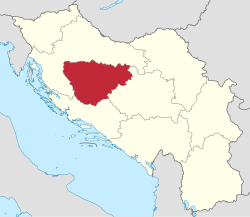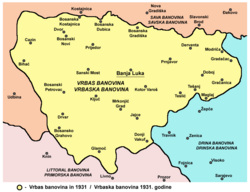Vrbas bank
The Banschaft Vrbas ( serbokroat. Vrbaska banovina , kyrill. Врбаска бановина ) was one of the nine banks of the Kingdom of Yugoslavia , which were formed on October 3, 1929. The capital, de facto provincial capital, was Banja Luka . The Banschaft included roughly the western part of Bosnia-Herzegovina . The bank got its name after the river Vrbas .
The Vrbas Banschaft had its representatives in the Yugoslav Senate (3), in the People's Representation (25) and in the Council of Banships (35). It was formed from the former districts of Vrbas and Bihać , parts of the districts of Travnik and Tuzla , and the southern part of the Banija in Croatia . The area was about 20,900 km² and was divided into 24 districts and 161 communities.
population
According to the 1931 census, the Vrbas Banschaft had a population of 1,037,382 people, of which the male population was about 51% and the female 49%. Yugoslavs of the Orthodox faith made up 57.89% of the population (in the Kgr.Yugoslavia censuses were not carried out according to nationality, but according to the language; Serbs , Croats and Bosniaks were summarized in the Serbo-Croatian language ), Yugoslavs of Islamic faith 24.13% and Yugoslavs Roman Catholic faith 16.66%. Protestants made up 0.31% and Yugoslav Jews 0.11% of the population.
Economy and Transport
The most important cities of the Banja Luka and Bihać , other important towns were Bosanski Novi , Derventa , Prijedor , Bosanska Gradiška , Bosanska Dubica , Doboj , Gračanica and Bosanski Brod . Significant advances have been made in the development of transport, agriculture, education and health.
history
The Banschaft Vrbas was created in 1929 with the reorganization of the Yugoslav state from the Kingdom of Serbs, Croats and Slovenes into the Kingdom of Yugoslavia under Alexander I. With the establishment of the Croatian Banschaft in 1939, smaller areas with Derventa in the northeast fell to the new Banschaft. After the attack by the Hitler regime on the Kingdom of Yugoslavia and the capitulation of Yugoslavia in 1941, the Banschaft Vrbas was added to the Ustaše State , which dissolved it and integrated it into its new territory. After the war, Bosnia-Herzegovina was formed in communist Yugoslavia within the borders before 1918 and as a federal republic, the Vrbas Banschaft was not renewed.
Web links
- Map (hungarian)



